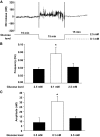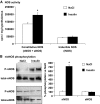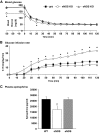Ventromedial hypothalamic nitric oxide production is necessary for hypoglycemia detection and counterregulation
- PMID: 19934009
- PMCID: PMC2809968
- DOI: 10.2337/db09-0421
Ventromedial hypothalamic nitric oxide production is necessary for hypoglycemia detection and counterregulation
Abstract
Objective: The response of ventromedial hypothalamic (VMH) glucose-inhibited neurons to decreased glucose is impaired under conditions where the counterregulatory response (CRR) to hypoglycemia is impaired (e.g., recurrent hypoglycemia). This suggests a role for glucose-inhibited neurons in the CRR. We recently showed that decreased glucose increases nitric oxide (NO) production in cultured VMH glucose-inhibited neurons. These in vitro data led us to hypothesize that NO release from VMH glucose-inhibited neurons is critical for the CRR.
Research design and methods: The CRR was evaluated in rats and mice in response to acute insulin-induced hypoglycemia and hypoglycemic clamps after modulation of brain NO signaling. The glucose sensitivity of ventromedial nucleus glucose-inhibited neurons was also assessed.
Results: Hypoglycemia increased hypothalamic constitutive NO synthase (NOS) activity and neuronal NOS (nNOS) but not endothelial NOS (eNOS) phosphorylation in rats. Intracerebroventricular and VMH injection of the nonselective NOS inhibitor N(G)-monomethyl-l-arginine (l-NMMA) slowed the recovery to euglycemia after hypoglycemia. VMH l-NMMA injection also increased the glucose infusion rate (GIR) and decreased epinephrine secretion during hyperinsulinemic/hypoglycemic clamp in rats. The GIR required to maintain the hypoglycemic plateau was higher in nNOS knockout than wild-type or eNOS knockout mice. Finally, VMH glucose-inhibited neurons were virtually absent in nNOS knockout mice.
Conclusions: We conclude that VMH NO production is necessary for glucose sensing in glucose-inhibited neurons and full generation of the CRR to hypoglycemia. These data suggest that potentiating NO signaling may improve the defective CRR resulting from recurrent hypoglycemia in patients using intensive insulin therapy.
Figures






Similar articles
-
Insulin regulates GLUT4 in the ventromedial hypothalamus to restore the sympathoadrenal response to hypoglycemia in diabetic rats.Am J Physiol Endocrinol Metab. 2018 Dec 1;315(6):E1286-E1295. doi: 10.1152/ajpendo.00324.2018. Epub 2018 Sep 18. Am J Physiol Endocrinol Metab. 2018. PMID: 30226996 Free PMC article.
-
Hypothalamic nitric oxide in hypoglycemia detection and counterregulation: a two-edged sword.Antioxid Redox Signal. 2011 Feb 1;14(3):505-17. doi: 10.1089/ars.2010.3331. Epub 2010 Aug 17. Antioxid Redox Signal. 2011. PMID: 20518706 Free PMC article. Review.
-
Hypothalamic S-nitrosylation contributes to the counter-regulatory response impairment following recurrent hypoglycemia.PLoS One. 2013 Jul 19;8(7):e68709. doi: 10.1371/journal.pone.0068709. Print 2013. PLoS One. 2013. PMID: 23894333 Free PMC article.
-
Modulation of β-adrenergic receptors in the ventromedial hypothalamus influences counterregulatory responses to hypoglycemia.Diabetes. 2011 Dec;60(12):3154-8. doi: 10.2337/db11-0432. Epub 2011 Oct 19. Diabetes. 2011. PMID: 22013013 Free PMC article.
-
Glucosensing neurons in the ventromedial hypothalamic nucleus (VMN) and hypoglycemia-associated autonomic failure (HAAF).Diabetes Metab Res Rev. 2003 Sep-Oct;19(5):348-56. doi: 10.1002/dmrr.404. Diabetes Metab Res Rev. 2003. PMID: 12951642 Review.
Cited by
-
Norepinephrine control of ventromedial hypothalamic nucleus glucoregulatory neurotransmitter expression in the female rat: Role of monocarboxylate transporter function.Mol Cell Neurosci. 2019 Mar;95:51-58. doi: 10.1016/j.mcn.2019.01.004. Epub 2019 Jan 17. Mol Cell Neurosci. 2019. PMID: 30660767 Free PMC article.
-
Brain Regulation of Cardiac Function during Hypoglycemia.Metabolites. 2023 Oct 18;13(10):1089. doi: 10.3390/metabo13101089. Metabolites. 2023. PMID: 37887414 Free PMC article. Review.
-
Insights into the role of neuronal glucokinase.Am J Physiol Endocrinol Metab. 2016 Jul 1;311(1):E42-55. doi: 10.1152/ajpendo.00034.2016. Epub 2016 May 17. Am J Physiol Endocrinol Metab. 2016. PMID: 27189932 Free PMC article. Review.
-
Ventromedial hypothalamic glucose sensing and glucose homeostasis vary throughout the estrous cycle.Physiol Behav. 2016 Dec 1;167:248-254. doi: 10.1016/j.physbeh.2016.09.021. Epub 2016 Sep 22. Physiol Behav. 2016. PMID: 27666162 Free PMC article.
-
Lipopolysaccharide (LPS) and tumor necrosis factor alpha (TNFα) blunt the response of Neuropeptide Y/Agouti-related peptide (NPY/AgRP) glucose inhibited (GI) neurons to decreased glucose.Brain Res. 2016 Oct 1;1648(Pt A):181-192. doi: 10.1016/j.brainres.2016.07.035. Epub 2016 Jul 26. Brain Res. 2016. PMID: 27473896 Free PMC article.
References
-
- The Diabetes Control and Complications Trial Research Group. The effect of intensive treatment of diabetes on the development and progression of long-term complications in insulin-dependent diabetes mellitus. N Engl J Med 1993; 329:977–986 - PubMed
-
- Amiel SA, Tamborlane WV, Simonson DC, Sherwin RS: Defective glucose counterregulation after strict glycemic control of insulin-dependent diabetes mellitus. N Engl J Med 1987;316:1376–1383 - PubMed
-
- Cryer PE: Glucose counterregulation in man. Diabetes 1981;30:261–264 - PubMed
-
- Routh VH, Song Z, Liu X: The role of glucosensing neurons in the detection of hypoglycemia. Diabetes Technol Ther 2004;6:413–421 - PubMed
Publication types
MeSH terms
Substances
Grants and funding
LinkOut - more resources
Full Text Sources
Medical
Molecular Biology Databases

